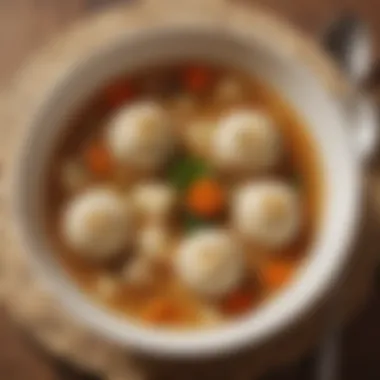Mastering Kosher Lunches for Passover Celebrations


Intro
The observance of Passover holds great importance in Jewish life, embodying a rich tapestry of traditions and beliefs. Among these practices, the kosher dietary laws take center stage, shaping what can be consumed during the festival. When planning a kosher Passover lunch, understanding the complexities of these laws is essential. This guide aims to navigate the intricacies of kosher food, presenting ideas that not just comply with religious guidelines but also inspire culinary creativity.
As Passover commemorates the exodus from Egypt, it is also a time to reflect on one’s culinary choices. The shift from leavened to unleavened bread signifies a departure from the familiar, expanding the palate in new directions. By harmonizing adherence to kosher laws with the quest for flavorful meals, individuals can uplift their holiday experience.
This exploration will cover the key components of a kosher Passover lunch, from essential dietary restrictions to practical meal ideas that respect tradition while providing variety. Each aspect is crafted to ensure a lunch experience that is both compliant and delightful, retaining the essence of the celebrations.
Understanding the constraints of Passover food is crucial, especially when planning a menu that excites the taste buds yet remains true to kosher guidelines. This article is dedicated to empowering readers with knowledge and inspiration, making it easier to honor the sacred while enjoying a diverse array of flavors.
Understanding Kosher for Passover
Understanding kosher for Passover is essential for anyone looking to create a meaningful and compliant meal during this important Jewish holiday. The process of observing kosher laws enhances the spiritual experience of Passover while also ensuring that food preparation aligns with deeply rooted traditions. Focusing on various unique aspects of the kosher guidelines during Passover will help individuals better appreciate the significance of their culinary choices.
Defining Kosher
The definition of kosher relates to the dietary laws derived from Jewish texts, establishing what foods can and cannot be consumed. Foods that adhere to these guidelines must originate from specific sources and must be prepared in a way that meets halachic requirements. During Passover, the term gains further importance due to added restrictions concerning the consumption of chametz—leavened products like bread and certain grains. Therefore, understanding kosher means not only recognizing permitted ingredients but also grasping the broader spiritual implications of these culinary choices in the context of the Passover holiday.
Passover Observances
Passover observances extend beyond mere dietary restrictions; they incorporate the values of freedom, family, and remembrance. The Seder meal, a cornerstone of the holiday, is more than a meal; it symbolizes the liberation of the Israelites from Egyptian bondage. Each component on the Seder plate has its own significance, and it is during this meal that the stories of the Exodus are brought to life. Observing kosher during Passover ensures that participants are fully engaged in the traditions and rituals associated with the holiday, thus fostering a deeper connection with their heritage.
The Role of Matzo
Matzo serves as a fundamental element of Passover, embodying the essence of the holiday. This unleavened bread represents both the haste of the Exodus and the humility of those who were freed. In a practical sense, matzo is used as a substitute for bread during the holiday, as eating leavened products is prohibited. It also plays a critical role in the rituals of the Seder, including the breaking and sharing of matzo. By including matzo in Passover lunches, individuals not only satisfy kosher requirements but also deepen their appreciation of the holiday's themes.
The Historical Context of Passover
Understanding the historical context of Passover is essential for grasping its significance in contemporary practices and traditions. The celebration of Passover is not merely a ritual; it is a profound connection to collective memory, identity, and faith. When exploring Kashrut for Passover Lunch, one must recognize how the past informs present-day guidelines and culinary choices. This not only enriches the meal experience but also plays a vital role in fostering a sense of community among those who observe these customs.
Origins of Passover
The origins of Passover are deeply rooted in the biblical narrative of the Exodus, where the Israelites were freed from slavery in Egypt. This liberation is commemorated by a series of observances that reflect both spiritual and communal aspects. The term 'Passover' itself comes from the Hebrew word Pesach, signifying the divine protection over the Hebrew homes during the final plague that led to their exodus. This historical event underpins the importance of freedom and redemption, themes that resonate in family gatherings and meals today.
Historically, Passover rituals have evolved, but the core messages of freedom and faith continue to guide modern practice. As one creates a kosher lunch for Passover, understanding this foundation allows for a deeper appreciation of the ingredients, recipes, and traditions involved.
Cultural Traditions
Cultural traditions associated with Passover are diverse and vary by community, yet they share common threads that showcase rich heritage and family values. Traditionally, families gather for a Seder, a ceremonial dinner where symbolic foods are utilized to retell the story of the Exodus. The foods included during the Seder, such as matzo and bitter herbs, serve to illustrate different aspects of the narrative and foster reflection on the hardships endured.
In addition to the Seder, many communities integrate unique customs that have developed over generations. For instance, the practice of singing traditional songs or encouraging children to ask questions engages participants, especially the younger generation, in understanding their heritage.
The preparation of food is imbued with significant meaning. Ingredients are often selected not just for their kosher status but for their cultural relevance. This emphasis on tradition enhances the Passover lunch experience, ensuring a blend of respect for the past while incorporating individual family legacies.
Key Dietary Restrictions During Passover
Understanding the key dietary restrictions during Passover is essential for creating meals that respect tradition and dietary laws. The rules derived from Jewish texts dictate what can and cannot be consumed during this significant holiday. Following these guidelines connects the meal to the historical and spiritual roots of Passover, making each bite more meaningful.
This section will cover two main aspects: chametz avoidance and ingredient limitations. Each plays a critical role in ensuring that foods prepared during this time adhere to kosher statutes while remaining nutritious and enjoyable.


Chametz Avoidance
Chametz refers to leavened foods made from wheat, barley, rye, oats, or spelt that have been allowed to rise. During Passover, Jewish dietary laws strictly forbid chametz consumption, mirroring the Jewish people’s exodus from Egypt, where they ate unleavened bread.
Avoiding chametz can be challenging, especially because it is present in many common foods. It is advisable to thoroughly clean kitchens and discard any chametz items before the holiday begins. Other tips include:
- Read labels carefully: Processed foods often contain hidden sources of chametz.
- Prepare fresh meals: Using whole, natural ingredients lowers the risk of accidental chametz content.
- Make use of matzo: As the main substitute for bread during this period, it can be incorporated into various recipes, from appetizers to desserts.
The restriction against chametz not only serves dietary purposes but also provides a reflective space for individuals to engage with their heritage. Without the distractions of leavened products, people may gain insight into their eating habits and appreciate simpler fare.
Ingredient Limitations
In addition to chametz avoidance, Passover comes with specific ingredient limitations that must be honored. This includes avoiding certain grains and legumes during the holiday, known collectively as kitniyot in many communities. While some allow these foods, others abstain. Therefore, understanding individual family customs is important.
Common ingredient restrictions during Passover include:
- Grains: Wheat, barley, oats, rye, and spelt are completely off-limits unless they are in the form of matzo.
- Legumes: While some accept beans, rice, and lentils, others do not. This varies by community tradition.
- Processed foods: Many processed items may include non-Passover compliant ingredients. Always check for certification by a reliable kosher authority.
"The importance of dietary restrictions during Passover goes beyond mere adherence; it fosters a profound connection to cultural history and personal identity."
Navigating these ingredient limitations requires creativity. Chefs often adapt traditional recipes using compliant substitutes while still offering delicious flavors. By remaining vigilant about these guidelines, one can ensure that meals are appropriate for Passover while also providing a rich dining experience that honors this unique occasion.
Crafting a Passover Lunch Menu
Crafting a Passover lunch menu is a vital element of the observance. A thoughtful menu can reflect the cultural heritage and dietary laws that guests hold dear. It ensures that each dish aligns with kosher practices while also being flavorful and satisfying. Careful selection encourages thoughtful conversations about traditions and deepens the connection to the holiday. Considerations like ingredient sourcing, flavor pairing, and dietary restrictions impact the overall experience. Each item on the menu should celebrate the essence of Passover and remain compliant with kosher rules.
Appetizers
A well-chosen appetizer can set the tone for the meal. Traditional choices like gefilte fish or charoset evoke memories and foster discussion about the customs of Passover. These starters are not just about taste; they carry stories and history. Furthermore, they allow the host to showcase creativity while maintaining adherence to dietary laws.
Main Courses
Roasted Chicken
Roasted chicken plays an integral role. Its simplicity allows for various flavor profiles, accommodating different preferences. Marinated with herbs and spices, it can be a show-stopper on the table. The key characteristic of roasted chicken is its ability to be both elegant and approachable. This versatility makes it a popular choice for Passover meals. One unique feature is its ability to be prepared in advance, allowing the host to focus on other aspects during the gathering. However, care must be taken to ensure it is properly cooked, remaining juicy and flavorful.
Vegetable Tzimmes
Vegetable Tzimmes offers a reflection of seasonal ingredients but also serves as a symbol of sweetness for the holiday. Its combination of carrots, sweet potatoes, and dried fruits provides a comforting side that many enjoy. This dish stands out for its key characteristic of being healthful yet satisfying, making it a valuable addition to any Passover menu. Tzimmes can be served warm or at room temperature, giving flexibility in preparation. The placement of Tzimmes can also educate guests about the mindful consumption of vegetables during the holiday.
Side Dishes
Quinoa Salad
Quinoa salad is gaining popularity among traditional choices. It’s packed with nutrients and can be customized to include seasonal veggies and herbs. As a beneficial option, quinoa is gluten-free and provides a protein-rich side. Its unique feature lies in its ability to absorb flavors, making it adaptable to many palates. However, one should ensure that ingredients remain kosher for Passover.
Roasted Root Vegetables
Roasted root vegetables enhance the meal's visual appeal while offering robust flavors. Their natural sweetness shines when caramelized, providing a stunning contrast to savory dishes. The key characteristic of these vegetables is their ability to stand alone or complement other flavors on the plate. They are a popular choice due to their ease of preparation and compatibility with kosher guidelines. They can be prepped ahead of time, simplifying serving when guests arrive.
Desserts


Flourless Chocolate Cake
Flourless chocolate cake often captivates dessert lovers. This rich, dense cake fits perfectly into Passover dietary restrictions while being decadent. The key characteristic lies in its simplicity; it uses minimal ingredients to maximize flavor. Its unique feature is its ability to serve as a centerpiece dessert while being gluten-free. However, portions can be dense, so moderation is advised.
Macaroons
Macaroons are another well-loved dessert. Their blend of coconut and egg whites leads to a chewy yet satisfying texture. These cookies often present a visual delight with their golden tops and vibrant fillings. The key characteristic of macaroons is that they embrace Passover laws while being sweet treats. While they are easy to make, using a proper recipe is essential to achieve the right consistency. Their popularity reflects a broader trend of adapting traditional flavors into modern contexts.
Adapting Traditional Recipes
Adapting traditional recipes is a significant aspect of preparing a kosher for Passover lunch. This process honors the rich history and cultural practices while ensuring compliance with dietary restrictions. By modifying classic dishes, you can keep the spirit of tradition without compromising on taste or authenticity.
The preparation for Passover often requires substantial changes in recipes, especially since many traditional ingredients may not meet kosher standards or might not be suitable during the holiday. It is essential to think creatively about substitutions that can enhance flavors while adhering to the guidelines of kosher cooking. Moreover, adapting recipes allows for innovation in the kitchen, providing opportunities to explore new flavors and textures.
Substitutions for Non-Kosher Ingredients
For those adhering to kosher for Passover principles, numerous common ingredients may require thoughtful substitutions. For example, if a recipe calls for regular wheat flour, it can be switched out for almond flour or coconut flour, both of which are inherently gluten-free and compliant. In place of yeast, which is often forbidden during this time, one can use baking soda combined with vinegar or egg whites as leavening agents. This not only adheres to dietary guidelines but can also create interesting alternatives that are worth trying.
Here are some potential substitutes:
- Sugar: Use honey or agave nectar instead, ensuring they are labeled kosher for Passover.
- Milk: Substitute with almond milk or coconut milk, providing richness without dairy.
- Butter: Opt for margarine or olive oil for a dairy-free option.
These substitutions allow cooks to maintain the essence of their cherished recipes while ensuring they are suitable for Passover. Understanding the ingredients deeply makes it possible to adapt with confidence.
Incorporating Seasonal Ingredients
Seasonal ingredients play a vital role in enhancing the quality and vibrancy of dishes. Using fresh produce adds nutritional value and bright flavors to Passover meals. For instance, spring is a time when many vegetables, such as asparagus, radishes, and artichokes, come into season. These ingredients can be beautifully incorporated into salads or side dishes to bring color and freshness to the table.
Buying seasonal produce not only supports local farmers but also ensures the maximum flavor and nutrition. Seasonal ingredients are more likely to be at their peak, offering the best experience when served. For example, roasted beet and carrot salad can be a stunning addition to a Passover lunch, showcasing seasonal bounty.
Generally, focus on:
- Herbs: Fresh dill, parsley, or mint can brighten dishes and introduce new taste profiles.
- Vegetables: Consider using green beans, fingerling potatoes, and leeks.
- Fruits: Strawberries or citrus can enhance desserts and add a fresh finish after a heavy meal.
Incorporating seasonal ingredients into your Passover lunch not only delights the palate but respects the rhythm of nature. This practice promotes creativity and allows one to share an exceptional dining experience with family and friends.
Serving Suggestions for Passover Luncheon
Serving suggestions for a Passover luncheon are critical. Creating a memorable meal is more than just the food. It can enhance the experience of the holiday and respect its traditions. Thoughtful presentation and pairing of food can elevate the meal, making it enjoyable and compliant with kosher guidelines.
Setting the Table
Using Kosher Utensils
Using kosher utensils is necessary for maintaining the integrity of a Passover meal. These utensils are specially designated for kosher use, and they help prevent any cross-contamination with chametz. They must be used only for kosher foods. This adherence to kosher practices not only fulfills religious requirements but also symbolizes respect for tradition.
When using kosher utensils, it is essential to ensure they are specifically marked or separated from other kitchen items. This is an important consideration for those hosting a Passover luncheon. It reinforces the notion that the meal is prepared with care and respect.
Additionally, using kosher utensils can offer peace of mind. This means that hosts can feel confident that their meal meets kosher standards, providing a shared sense of security for all attendees.
Passover Table Decor


Passover table decor serves as an essential element in creating the right atmosphere. A well-decorated table can reflect the significance of the celebration while inviting guests into a warm and engaging environment. The key characteristic of Passover decor is its ability to reflect cultural narratives and seasonal themes. It enhances the overall dining experience.
Unique features of Passover table decor often include elements like matzo covers, Seder plates, and festive colors that reflect the holy tone of the holiday. Simple yet elegant decorations can create a calm and respectful environment, aligning with the values of Passover. This decor is an important aspect of the meal, as it visually connects the meal to the traditions it celebrates.
Pairing Food and Wine
Pairing food and wine is an integral part of the Passover luncheon experience. It allows flavors to complement each other, creating a harmonious meal. Kosher wines are available in a variety of styles and can enhance the taste of the dishes served.
When selecting wine, consider the flavors of the main courses. For instance, a roasted chicken might pair well with a crisp Sauvignon Blanc, while a hearty vegetable tzimmes may be complemented by a smoother Merlot.
Ultimately, thoughtful pairing can enhance not only the flavors on the plate but also the overall enjoyment of the meal. Paying attention to these details results in a lunch that resonates with both tradition and culinary delight.
Food Safety Considerations
Food safety during Passover is paramount. Adherence to kosher laws goes beyond mere dietary restrictions; it embraces the sanctity of the holiday and guarantees nourishment is both safe and healthy. Proper management of food safety ensures that traditional meals can be enjoyed without the risk of illness. Understanding food safety involves recognizing specific processes from storage to preparation, especially within the context of Passover.
Storage Guidelines for Passover
When managing food storage for Passover, careful planning is essential. All foods must be kept in adherence to kosher laws, necessitating a scrupulous approach to storage methods. Here are several critical points to consider:
- Separation of Foods: All items must be stored in a way that prevents cross-contamination between kosher and non-kosher products. Use separate storage containers and labeling systems.
- Temperature Control: Perishable items should be kept at recommended temperatures. This is particularly crucial for meats and dairy products to ensure they remain safe to consume.
- Shelf Life Awareness: Regularly check expiry dates and ensure food items are consumed within recommended timeframes. This is vital not just for flavor but for safety.
- Matzo Handling: Given that matzo is a central feature, it should be stored in a dry, cool place to maintain its quality during the holiday.
Understanding Cross-Contamination
Cross-contamination is a significant concern in food safety, especially during Passover. Mishandling can lead to the unintentional mixing of chametz with kosher-for-Passover foods, which is strictly prohibited. To maintain strict standards and avoid contamination, consider these practices:
- Dedicated Utensils: Always use dedicated cookware and utensils for Passover dishes. This avoids any transfer of chametz from previous meals.
- Thorough Cleaning: Prior to Passover, a complete deep-cleaning of kitchen spaces is advisable. Pay special attention to all surfaces, as even traces can lead to issues.
- Segregation During Preparation: When preparing food, organize your workspace in a way that separates kosher-for-Passover ingredients from others.
Effective food safety practices not only honor Passover traditions but also safeguard health. Proper awareness ensures that meals served are both delicious and safe for consumption.
Maintaining proper food safety considerations during Passover reflects respect for its customs while ensuring the well-being of all participants. Paying close attention to storage guidelines and understanding the risks of cross-contamination lays the foundation for a holiday that is as safe as it is celebratory.
Ending: Embracing Tradition with Innovation
As we reflect on the complexity and significance of kosher practices during Passover, it becomes clear that embracing tradition while innovating within those guidelines is essential. This balance allows for the maintenance of cultural heritage while also adapting to modern culinary trends and preferences. By understanding the rigorous dietary laws and their historical roots, food lovers can become more creative in their kosher cooking.
The benefits of integrating innovation include enhanced flavor profiles, diverse meal options, and an opportunity to engage different culinary techniques. Furthermore, this approach can captivate a wider audience, ensuring that those observing Passover can enjoy meals that are both meaningful and satisfying.
"Tradition is not the worship of ashes, but the preservation of fire."
This quote, attributed to Gustav Mahler, emphasizes the importance of preserving the essence of Passover through food while allowing for new interpretations that appeal to contemporary tastes. The conversation around kosher cooking does not have to stagnate; instead, it should evolve to meet the needs of the current generation.
Reflecting on Dietary Laws
The examination of dietary laws during Passover highlights the need for discipline and respect for tradition. Adhering to these guidelines fosters a sense of community and shared values among practitioners. Furthermore, understanding these laws contributes to a deeper appreciation for the history and significance behind each culinary choice made during this time.
Many kosher food practices promote mindfulness about what we consume. This awareness often extends beyond Passover, encouraging individuals to make thoughtful choices regarding sustainability and health. Moreover, the reflection on dietary laws serves as a reminder of the spiritual dimensions intertwined with food and its preparation.
The Future of Kosher Cooking
In considering the future of kosher cooking, we observe a growing interest in integrating global culinary influences while still adhering to kosher standards. Innovative chefs are finding ways to incorporate flavors and techniques from various cuisines into traditional dishes, resulting in exciting combinations that honor tradition while offering something novel.
There is potential for industry growth through the development of new products and recipes that comply with kosher guidelines. This shift parallels broader trends in dining, where consumers seek authenticity and unique experiences. These changes must occur alongside a steadfast adherence to kosher laws, ensuring that integrity remains at the forefront of this culinary evolution.
Ultimately, the future of kosher cooking hinges on open-mindedness and adaptability. When we allow ourselves to explore without losing sight of our traditions, we foster communities united by both heritage and shared gastronomical experiences.
By embracing innovation within the framework of dietary laws, we pave the way for a more vibrant and inclusive culinary environment that respects the past while looking ahead.















